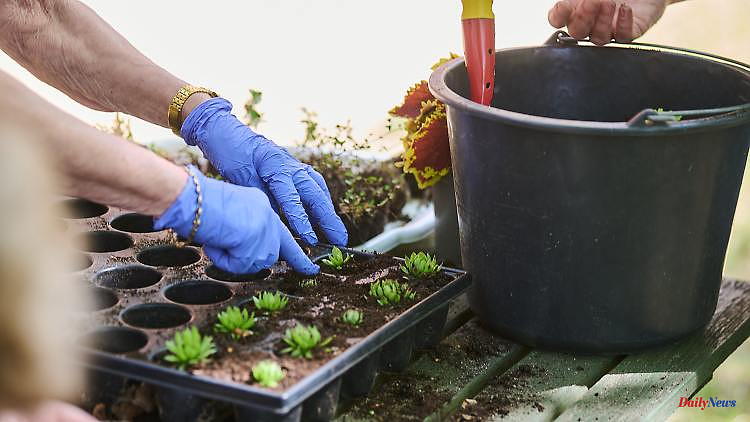Even in ancient times it was thought that gardening could have a positive effect on the psyche. Today, therapists also use digging, planting and weeding to alleviate many other ailments.
Christel Haas carefully disassembles a stone rose and gradually plants the individual rosettes in the moist soil of a seed tray. "It calms me down and it makes me happy when I see plants growing," says the 88-year-old Berliner. She hasn't had her own garden for a long time. The pensioner is a patient in the geronotopsychiatric department of the Evangelical Hospital Herzberge in Berlin. Gardening is part of the therapy program there.
The historic, red brick clinic building is surrounded by greenery, old trees and is located in the Herzberge landscape park. In the garden of the Geronton psychiatric clinic, therapist Marlit Bromm has planted flower beds with her patients. Young vegetables are growing in the raised beds.
Christel Haas is being treated for anxiety attacks. Other patients come to the clinic with depression, psychotic disorders, fears, states of confusion or behavioral problems, for example in the course of dementia. The patients are often irritable, aggressive or cry a lot, says the medical director Torsten Kratz. Horticultural therapy can help minimize behavioral problems. "Working in the countryside lifts the spirits and increases motivation without any medication," says Kratz. "Through gardening, for example, patients with depression regain momentum by actively doing something. Often they no longer dare to do anything." For people with dementia, on the other hand, therapy through memory helps. "They are disoriented and have lost the memory of their past. But most patients of the older generation have a connection to nature, have had their fingers in the ground before, even if it's only when they were stealing turnips during the war," says the doctor.
Gardening offers support and orientation, simply through the familiar, recurring course of the seasons, adds garden therapist Bromm. Another positive effect: "The patients, who otherwise play a more passive role, now actively take care of something, take responsibility for the plants. The cared for becomes the carer," says Kratz. Twice a week, patients can weed, sow, plant, cut or - for example in winter - work creatively with plants and other natural materials. From Bromm's point of view, garden therapy is a mindful experience of nature that goes far beyond physical work. "It's also about pausing, finding one's way in nature, perceiving things and arriving in the here and now."
According to the American Horticultural Therapy Association (AHTA), therapeutic aspects of gardening have been described since ancient times. In the 19th century, the doctor Benjamin Rush first described positive effects on people with mental illnesses. In the 1940s and 1950s, the form of therapy was also used in the rehabilitation of war veterans. Horticultural therapy is now used for a wide range of diseases.
"The techniques help to learn new skills or to regain lost skills," writes the AHTA. Garden therapy could improve memory, cognitive and language skills, for example. Muscle strength, sense of balance and endurance can also be strengthened. However, this type of therapy is not suitable for everyone, explains Kratz: "It only helps with people who also have a pleasant connection to the garden. That's why we do biographical work beforehand to see what suits the patient." His house also offers other non-drug methods, such as Qi Gong. About 17 years ago, the clinic was one of the first in Germany to include garden therapy in inpatient treatment, says Kratz. It's not a cash benefit, "but we think it's important."
Hospitals offering horticultural therapy are still rare. "Garden therapy is mainly found in old people's care and in rehabilitation facilities for psychiatry and addiction, and increasingly also in the educational field," says Andreas Niepel, President of the International Society for Garden Therapy. It's also a question of funding. In the rehabilitation sector, this is covered by the German pension insurance.
Niepel estimates that around 300 to 400 garden therapists work in Germany. Independent training does not exist here, but further training opportunities do. Many garden therapists are occupational therapists or educators in their main profession. In other countries, such as Great Britain and the USA, the form of therapy is more widespread. It is also taught there at various universities, according to Niepel, who has headed the garden/garden therapy department at a specialist clinic for neurological and neurosurgical rehabilitation in Hattingen in North Rhine-Westphalia for 30 years.
The form of therapy can also be used in neurology: "For example, if people have to learn how to use both hands in a coordinated manner after a stroke, to control their torso, to walk, to stand, gardening can be used well for this." "Meanwhile, many studies have proven the positive effect of garden therapy on health and well-being," says Niepel, who presents and comments on the studies on Instagram. In his book "Well-Being Gardeners" he also addresses young gardeners and, based on his experiences from garden therapy, describes how people with different demands on their piece of greenery can be happy and satisfied.
(This article was first published on Friday, June 24, 2022.)












